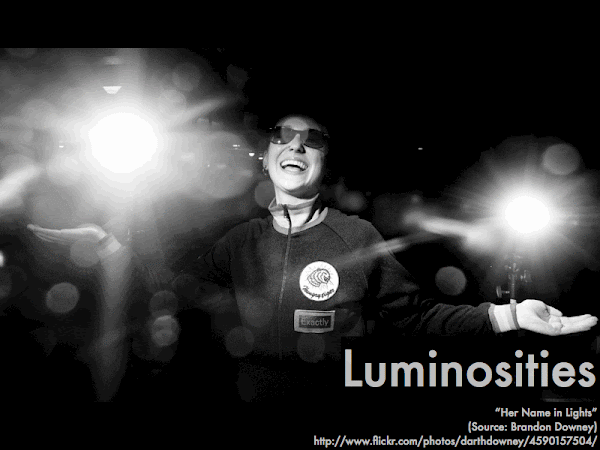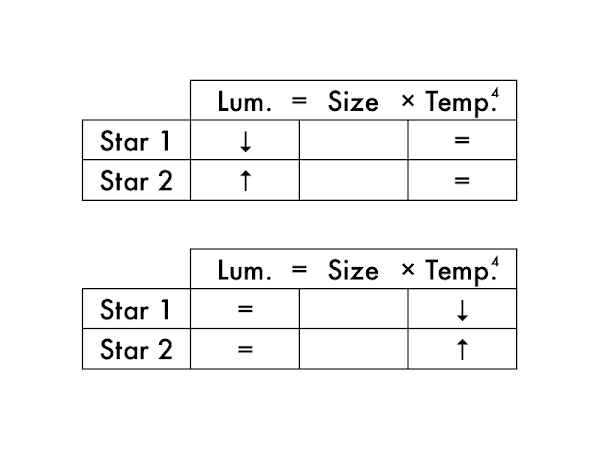Cuesta College, San Luis Obispo, CA
Students have a weekly online reading assignment (hosted by SurveyMonkey.com), where they answer questions based on reading their textbook, material covered in previous lectures, opinion questions, and/or asking (anonymous) questions or making (anonymous) comments. Full credit is given for completing the online reading assignment before next week's lecture, regardless if whether their answers are correct/incorrect. Selected results/questions/comments are addressed by the instructor at the start of the following lecture.
The following questions were asked on reading textbook chapters and previewing presentations on parallax, distance, apparent magnitude, absolute magnitude, Wien's law and the Stefan-Boltzmann law.

Selected/edited responses are given below.
Describe something you found interesting from the assigned textbook reading or presentation preview, and explain why this was personally interesting for you.
"That we are able to find out the size of a star based upon its luminosity and temperature."
"Wien's law is neat because you can tell how hot a star is by just looking at what color it is."
"The H-R diagram--because this gives you an idea of how big, how hot, and how other stars are related to the sun."
"White hot stars are hotter than the red ones."
"I never knew that there was this much information on stars. I'm totally interested but I'm totally confused at the same time."
Describe something you found confusing from the assigned textbook reading or presentation preview, and explain why this was personally confusing for you.
"Pretty much everything."
"The differences between apparent and absolute magnitude."
"How to calculate distance and brightness! Oh my gosh, help!"
"The S-B Law because I just don't understand how it works."
"The stars and all of their classifications! After the video [Wonders of the Universe: Stardust] last week, I became aware of how much there is to know about stars and I was blown away. And I knew this was going to trip me up. So just all the information and keeping it straight is the hardest part."
Explain how apparent magnitude and the absolute magnitude are defined differently.
"Apparent magnitude is how bright a star looks like from the naked eye and absolute magnitude is how bright a star really is (once the distance of the star is accounted for)."
"Apparent magnitude is how bright we see a star, regardless of its distance from the earth. Absolute magnitude is how bright a star would appear if we put it at 32.616 light-years [10 parsecs] away."
"I'm unsure."
"Apparent is a guesstimate, and absolute is exact."
Suppose the sun was moved to a distance of 10 parsecs away. As a result, its __________ magnitude would become dimmer.
absolute. ********* [9] apparent. ******************* [19] (Both of the above choices.) ***** [5] (Neither of the above choices.) [0] (Unsure/guessing/lost/help!) **** [4]
Rank the temperatures of these stars (1 = hottest, 4 = coolest; there are no ties).
(Only correct responses shown.)
Hottest: blue main sequence star [81%]
Second hottest: white main sequence star [76%]
Third hottest: yellow main sequence star [84%]
Coolest: red main sequence star [92%]
Rank the temperatures of these stars (1 = hottest, 4 = coolest; there are no ties).
(Only correct responses shown.)
Hottest: blue supergiant [78%]
Second hottest: white dwarf [51%]
Third hottest: yellow supergiant [64%]
Coolest: red dwarf [87%]

dimmer. ****** [6] brighter. **************************** [28] (These stars would be the same size.) [0] (Unsure/guessing/lost/help!) *** [3]
Two stars (equally far away) have the same brightness, but one star is cooler, and the other star is hotter. The __________ star will be larger in size.
cooler. ********************* [21] hotter. ********* [9] (These stars would be the same size.) **** [4] (Unsure/guessing/lost/help!) *** [3]
Ask the instructor an anonymous question, or make a comment. Selected questions/comments may be discussed in class.
"More examples and charts would be good. Please go over the distance of the stars and what is cooler/hotter and dimmer/brighter." (Yes.)
"Parsecs (pc) are better than light-years (ly)!" (Yes.)
"Do we need to memorize all of these equations?" (What equations? More seriously, you do need to "memorize" the logical reasoning behind the mathematics we'll be learning this week in order to apply it to quiz and exam questions.)
"What are you going to be for Halloween?" (Come to Madonnaween at the Madonna Inn the Monday before Halloween, and find out. I'm not dressing up as a DJ, but I am DJing!))
No comments:
Post a Comment